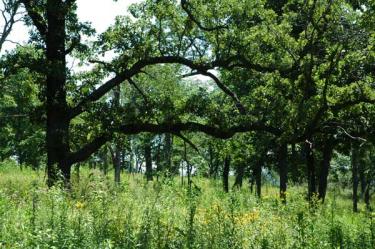Regenerating Oaks
Whether you’d like to restore a lost oak woodland or create a new one, you can take an active role in growing tomorrow’s trees. Regenerating oaks requires selecting a good site, starting new trees, and then caring for the trees as they get established in your woods.
Picking your site. The first step is to choose a good site for oaks. The best sites are south- or west-facing slopes or ridge tops where the soil is well-drained. Oaks can do well in heavier soils too, if you control competition from other trees and vegetation. Old pastures (where livestock no longer graze) with large oaks that can produce seeds or sprouts for future growth are especially good choices. But wherever your site is, good drainage is key, and the better your soil conditions at the site, the better your chances for oak survival.
Preparing your site. Depending on the conditions in your woods, you may need to prepare the site with forest management activities—such as thinning, harvesting, prescribed burns or pest/disease control—that create the right conditions for young oaks to grow. If you’re working with an area that already has some oaks, try to keep some of your seed-producing trees intact. Also protect the younger oaks in your woods—younger trees tend to produce more stump sprouts.
Choosing your trees. Choosing the right oak will give you your best chance at establishing healthy oak woodlands—and with 50 native species to choose from, finding the right one may not be easy. Talk to your forester or contact a state forestry agency to determine which oaks would grow best in your selected site.
Regenerating your trees. Once you’ve chosen the oaks you want in your site, you’ll need to get them started. If you already have some oaks on your property, natural regeneration is possible. Your existing trees can produce acorns or root or stump sprouts that will eventually grow into new oaks. Watch for these, and protect them from browsing animals, competing vegetation and too much shade so they can grow.
If you don’t currently have oaks, or don’t have enough for your regeneration needs, then artificial regeneration may be a better option. This just means purchasing seeds or seedlings from a nursery and planting them. Your forester or state forestry agency can direct you to a good seedling source.
Take care of your oaks. Regenerating oaks need some care in their early days, and that can involve pruning, fertilizing, sheltering and other activities that keep them healthy. Sheltering is especially useful when trees are very young and vulnerable to browsing by deer and other forest creatures. Tree shelters form a barrier between nibbling animals and tender oaks until the trees are mature enough to withstand browsing.
Pruning can also be helpful early on. It encourages vertical growth in young trees, and lets more sunlight into your woods. You may want to consult a forester for guidance on pruning, because it must be done properly and at the right time of year (ideally, in the late winter or early spring, before new growth occurs) so as not to leave the tree susceptible to disease or pests.
Fertilizing should also be done with care, as young oak seedlings are sensitive to excess nitrogen. Test your selected site first, to get a sense of your nutrient needs before planning your fertilizing routine.
All of these activities—preparing your site, taking care of your young trees, and maintaining your oak forest with careful forest management—can help you establish healthy oak woodlands on your land. That’s an investment that will pay off for you and your property, and a gift to oak-lovers for generations to come.
Learn More
- Oak Tree Care and Acorn Collecting in California
- Growing Your Own Oak Seedlings from Mississippi State Extension
- Acorns to Oaks in Iowa from WildBirds.org
- How to Grow California Oaks from Acorns from the University of California
- Producing Live Oaks from Seed: Texas A&M Extension
- Planting Native Oaks in the Pacific Northwest from the US Forest Service
- Woodland Owners Guide to Oak Management from the University of Minnesota Extension
- Northern Red Oak Regeneration: University of New Hampshire
How can I get more tips?
It’s simple! Enter your email below.

